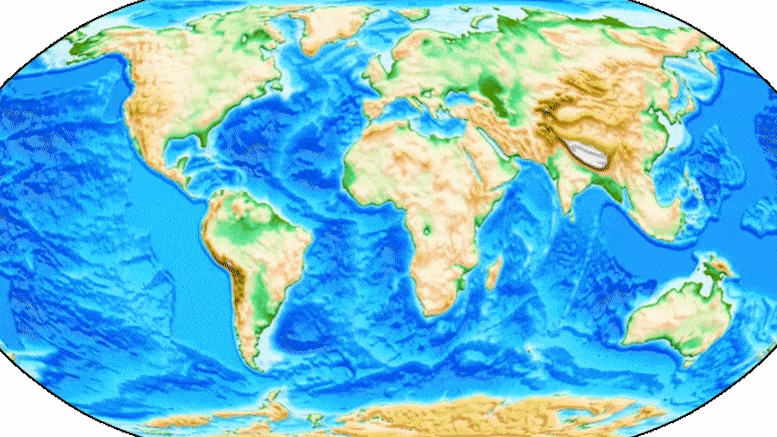
Scientists have published research indicating that movements in Earth’s tectonic plates indirectly stimulate bursts of biodiversity through 36-million-year cycles by causing sea levels to rise and fall. They believe that these geological cycles, traceable back 250 million years, critically influence marine species diversity. This animation is a 250 million-year re-creation of the geography of Earth, showing the interplay between plate tectonics and sea level variations. Credit: Paleomap Project and Michael Chin
Tectonic changes alter sea levels which can create breeding grounds for life.
Researchers have discovered that Earth’s tectonic plate movements cause sea levels to rise and fall in 36-million-year cycles, indirectly triggering biodiversity bursts. These cycles, altering shallow sea and shelf habitats, are found to significantly shape marine life diversity over millions of years, challenging previous notions of species evolution.
Movement in the Earth’s tectonic plates indirectly triggers bursts of biodiversity in 36‑million-year cycles by forcing sea levels to rise and fall, new research has shown.
Researchers including geoscientists at the University of Sydney believe these geologically driven cycles of sea level changes have a significant impact on the diversity of marine species, going back at least 250 million years.
As water levels rise and fall, different habitats on the continental shelves and in shallow seas expand and contract, providing opportunities for organisms to thrive or die. By studying the fossil record, the scientists have shown that these shifts trigger bursts of new life to emerge.
The research was published on July 10 in the journal Proceedings of the National Academy of Sciences, led by Associate Professor Slah Boulila from Sorbonne University in Paris.
250 million-year re-creation of the geography of Earth, showing the interplay between plate tectonics and sea level variations. Credit: Paleomap Project and Michael Chin
Study co-author Professor Dietmar Müller, from the School of Geosciences at the University of Sydney, said: “In terms of tectonics, the 36-million-year cycle marks alterations between faster and slower seafloor spreading, leading to cyclical depth changes in ocean basins and in the tectonic transfer of water into the deep Earth.
“These in turn have led to fluctuations in the flooding and drying up of continents, with periods of extensive shallow seas fostering biodiversity.
“This work was enabled by the GPlates plate tectonic software, developed by the EarthByte Group at the University of Sydney, supported by Australia’s National Collaborative Research Infrastructure Strategy (NCRIS) via AuScope.”
The team based their findings on the discovery of strikingly similar cycles in sea-level variations, Earth’s interior mechanisms, and marine fossil records.
Scientists now have overwhelming evidence that tectonic cycles and global sea level change driven by Earth’s dynamics have played a crucial role in shaping the biodiversity of marine life over millions of years.
“This research challenges previous ideas about why species have changed over long periods,” Professor Müller said.
“The cycles are 36 million years long because of regular patterns in how tectonic plates are recycled into the convecting mantle, the mobile part of the deep Earth, similar to hot, thick soup in a pot, that moves slowly.”
Professor Müller said the Cretaceous Winton Formation in Queensland serves as a prime example of how sea-level changes have shaped ecosystems and influenced biodiversity in Australia.
The formation, renowned for its collection of dinosaur fossils and precious opal, provides a valuable window into a time when much of the Australian continent was flooded.
As sea levels rose and fell, the flooding of the continent created expanding and contracting ecological recesses in shallow seas, providing unique habitats for a wide range of species.
“The Cretaceous Winton Formation stands as a testament to the profound impact of these sea-level changes, capturing a snapshot of a time when Australia’s landscape was transformed and fascinating creatures roamed the land,” Professor Müller said.
Reference: “Earth’s interior dynamics drive marine fossil diversity cycles of tens of millions of years” by Slah Boulila, Shanan E. Peters, R. Dietmar Müller, Bilal U. Haq and Nathan Hara10 July 2023, Proceedings of the National Academy of Sciences.
DOI: 10.1073/pnas.2221149120


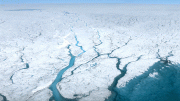
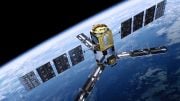
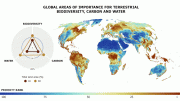


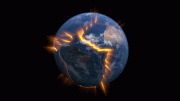

This isn’t really new. If I remember correctly, it has been claimed previously that there are extinction cycles of approximately 27 MY, based on Fourier analysis of the fossil record.
This really shouldn’t be too surprising. As mountain ranges rise, and subsequently erode, terrestrial ecological niches are created, and then destroyed, because of the lapse rate of the atmosphere. That is, the additional surface area created by uplifting mountain ranges, along with the cooling with elevation, create new challenges and opportunities for evolution of terrestrial life. Thus, new ecosystems are created (and destroyed) during the tens of millions of years longevity of subduction zones. Concurrently, the amount and type of fertilizing sediment transported into the oceans varies over time, creating favorable and unfavorable conditions for marine organisms.
To paraphrase an old geology joke: “It’s plate tectonics all the way down!”
Someone says this every 36 million years, and they have never been right before…
So, after billions of wasted climate change scare tactics about my little diesel car causing sea level change, we now create ANOTHER new billion dollar bureaucracy to tell us it’s plate tectonics, which is VERY logical after all.
This article is fantasy. There never was continental drift. There was planet shrinkage. The continents resemble puzzle pieces due to unit function effects. The puzzling is the naivity of the persons that believe Pangea.
You aren’t the first to make this claim. However, most of them were practicing geologists back in the ’70s. Most of them are dead now. Their concerns and alternative hypotheses, which you don’t address, were answered to the satisfaction of the rest of the geology community. If you have new evidence, you should present it. Otherwise, nobody is going to take you seriously.
I just wonder that if the west side of the America continet and the east side of the eas asia have more stable oceancide contimental biome.
Coincidentally we cross the plane of the galaxy every 35-40 million years which would result in periodic higher dark matter concentrations.
Your comment about the solar system crossing the plane of the Milky Way Galaxy in a sinusoidal wave may help explain why we some times have non-primary extinction and growth events, and sometimes we skip extinction and growth events. It is all about simultaneous hitting or missing passing thru a specific arm of the M W Galaxy as we cycle around the Galaxy. Look at my comment around two below you comment on the 36 MY Article from SciTechDaily.
So rising sea levels because of global warming is B.S.. just another way for governments to control. It’s all natural cycles in weather and nature.
There is a 186.6 million year PRIMARY extinction cycle with the “last one” being at 66.043 million years ago, with 8 sub cycles that average 23.325 million years, but the spacing is not uniform. The Primary Cycle is roughly 66 Mya, 252.6 Mya, 439.2 Mya, 625.8 Mya, 812.4, 999.0, 1185.6, etc. Just keep adding 186.6 to get back to the next PRIMARY
extinction even. The other seven in between some times occur, and some times do not occur. These are also growth cycles of the Earth, and all orbs in the solar system.
There is always a long time delay between growth events, and when the Earth heats up enough to actually grow larger by thermal expansion cycles. The result is that with each cycle first more water comes up out of the planets, so Ocean levels rise, and flood over continents, then the Earth expands slightly creating more surface area, so ocean levels fall, and pour off the continents. Biodiversity reacts to increasing, and decreasing availability of shallow marine environments with the creation of new seas on land, and the retreat of seas off land. If you like this information, I would recommend getting a copy of ” A Correlated History of the Earth “, a wall chart from the Black Hills Institute. His time line in the lower right box uses 186.0 MY, but the Earth is 4544.4 million years old, so subtracting 66 from 4544.4 gives 4478.4 and dividing by 24 Primary Cycles gives 186.6 MY per Primary Cycle. 23.325 X 195 = 4548.325 – 4544.4 = 3.975 MYF. This is about the time we will enter the Orion Arm of the Milky Way Galaxy.